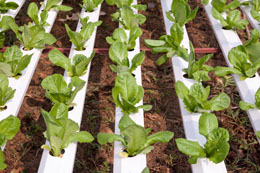Hydroponics or soilless gardening is a way of growing plants in nutrient solutions. Learn more about it from the following article.

Hydroponic gardening is a method of growing plants without using soil. The term hydroponics is derived from the Greek words
hydro for water and
ponics for labor. Though the concept of soilless gardening existed since a long time, scientists started experimenting with it only in the 1950s. In this type of gardening, mineral nutrient solutions are used instead of soil for the purpose of growing both, aquatic and terrestrial plants.
The plants can be grown effectively in mineral solutions solely or in an inert medium such as gravel or mineral wool. Many hobbyists prefer indoor hydroponic vegetable gardening in which almost all types of vegetables are grown under artificial light conditions. Vegetables grown using this method are 20-30 percent larger in size than those grown in the traditional manner.
In this type of gardening, the growing medium serves the functions of soil like, supporting the root system, maintaining pH, and channelizing nutrients and water to the roots. In recent times, several types of hydroponic systems have been developed based on the growing medium. Some of them are perlite, gravel, sand, Hydroton (expanded clay medium), expanded shale, and Rockwool (prepared from volcanic rocks).
Hydroponic nutrient solution or hydroponic fertilizer contains all the necessary plant nutrients (micro and macronutrients). These solutions are available in ready-made, concentrated forms. Usually, there are two types of nutrient solutions. One is used during the growth stage, while the other is used after the plant starts flowering. One should follow the manufacturer's guidelines while using these solutions.
Hydroponic gardening has several advantages over the traditional method of gardening. The growth rate of plants grown under soilless conditions is 35-45 percent more than those grown in soil. Consequently, the crop yield of hydroponic plants is higher than the plants grown in soil. This may be due to the difference in the nutrient and water availability. As hydroponic plants are grown in mineral solution, the plant roots can absorb nutrients and water directly. However, in case of plants grown in soil, the root system searches for the nutrients and water in the soil, and then converts the complex nutrient substances into simple absorbable forms to distribute them to the other plant parts.
As there is optimum oxygen in the growing medium used in this gardening, the root systems of these plants are more healthy in comparison to soil plants. A healthy root system is always beneficial for faster nutrient absorption and growth. Another advantage is that, chances of the plants getting infested by pests and bugs are minimum. Hence, vegetables and crops grown via hydroponics require little or no pesticides. Since no soil is used for gardening, soil-related problems are avoided as well. People residing in any part of the world can practice hydroponic gardening.
Disadvantages involved in this practice are very few. Due to high humidity and availability of nutrients, there are chances of salmonella (bacterium) growth. As the plants are exposed to extra water throughout their growth, diseases such as damping off and verticillium wilt are common.
In order to troubleshoot such problems, one should observe the plants carefully. Most common issues arise due to water problems, humidity, pH, and temperature. If the water supplied is not sufficient, plants exhibit slow growth rate and charring of leaves at the tips. Whereas, excess water causes root rot. It is always advisable to measure the pH of the nutrient solution regularly (ideal value is 5.5 to 6.5). Maintaining a moderate temperature is essential as extreme conditions can affect the leaves and roots of the hydroponic plants.






 Hydroponic gardening is a method of growing plants without using soil. The term hydroponics is derived from the Greek words hydro for water and ponics for labor. Though the concept of soilless gardening existed since a long time, scientists started experimenting with it only in the 1950s. In this type of gardening, mineral nutrient solutions are used instead of soil for the purpose of growing both, aquatic and terrestrial plants.
Hydroponic gardening is a method of growing plants without using soil. The term hydroponics is derived from the Greek words hydro for water and ponics for labor. Though the concept of soilless gardening existed since a long time, scientists started experimenting with it only in the 1950s. In this type of gardening, mineral nutrient solutions are used instead of soil for the purpose of growing both, aquatic and terrestrial plants.